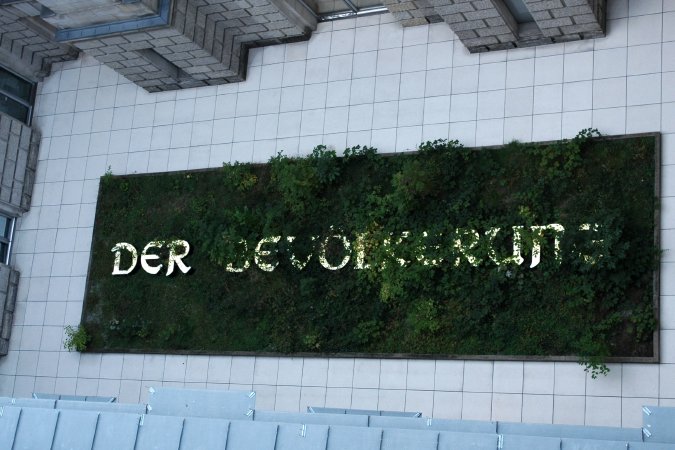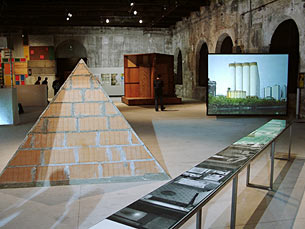This is evident in the work of Cildo Meireles. His Circuit series investigates popular media objects and the relation they have to societal hierarchies of power.

However, the artists in the Ultrabaroque show also investigate the heterogeneity of Latin culture. The culture of Latin countries can no longer be culturally defined on a national level, but instead the artistic investigation is post-national and looks at the heterogeneous nature of regional culture. The transcultural status of these countries largely results from the effects of colonialism. The post-colonial state also contributes to the contemporary issues of hierarchy and unequal distribution of power.
Jose Antonio Hernandez-Diaz's work incorporates religious connotations with popular cultural objects and imagery combined to describe the contemporary condition of Latin America that is largely influenced by its colonial history. In the work below, Hernandez-Diaz uses the washboard as a signifier for the cleansing of the skin, or ethnic cleansing.

The term baroque has conflicted meanings. Some scholars believe it to be the decline of a civilization while others see it as a complex investigation or advance of a civilization and questioning the power structures that operate within a society. If we take it to mean the latter, I believe Hans Haacke would fall into the category of the baroque. I recently went to hear him talk, and political upheaval is evident in almost all of his works. As a German-born artist, he is bringing a different perspective to politics in America that allow for a comparison between German and American histories, resulting in transculturalism. It may be a stretch to include him in this discussion, but much of the hybridization and transcultural perspective mentioned in the Ultrabaroque readings made me think of his talk. For example, regarding the picture below he had mentioned that he was thinking of the American flag over the face acting as a blinder to the implied American that is under the "bag."

However, because of the pervasiveness of the Abu Ghraib photographs, the viewer now sees the image as the American flag being put over the head of the "other" as a torture device. A reading of a work that was first national has become transnational due to contemporary events. Much of Haacke's work questions the systems and hierarchies of power and decision-making in our country, which was of much importance to the Ultrabaroque artists. Below is a public art piece in a political plaza. The sign on the from of the building contained the words Dem Deutschen Volke, which translated to "the German people," but culturally meant the people of Arian blood. The word Haacke used, DER BEVÖLKERUNG was used to describe people equally. This caused a politically controversy that had to go to parliament to see if the work could be installed. This questioned, not only the use of language, but a history of violence and suffering toward a group of people.

Although baroque is a term that has become the Euro-American cliche description of Latin American art, baroque, as used in show, signifies the complexities involved in visually describing a turbulent and complicated culture. This "impure beauty," as describe by Elizabeth Armstrong is not only evident in the technical aspect of the works, but also in the conceptual framework. Adrianna Varejao's work investigates the histories of colonial expansion and the effect it has on traditional Latin American cultures.

Meyer Vaisman looks at the affect of the transcontinental economy. This type of touristic economy relies largely on the commodification and marketability of culture.
 These works make us question the histories that have been taught to us and how we think about the commodified culture of the "other," which is the way in which we generally experience other cultures. He blends high and low culture by working with everyday materials and imagery, yet questions the way in which our experiences our mediated by our outsider attitude.
These works make us question the histories that have been taught to us and how we think about the commodified culture of the "other," which is the way in which we generally experience other cultures. He blends high and low culture by working with everyday materials and imagery, yet questions the way in which our experiences our mediated by our outsider attitude. I found the idea of allegory in relation to the baroque to be very interesting in terms of postmodern artistic practice. While we generally associate allegory with Renaissance art, the postmodern desire to link our contemporary conditions to the affects of the past is evident in the work in the Ultrabaroque show. I was thinking about the combination of contemporary media and religious imagery in terms of my own project for this class, which deals with the pervasiveness of the Madonna ideal in contemporary representations of motherhood, and what that means for contemporary notions of identity.
The idea of colonial displacement was also a large topic in the Ultrabaroque show. Arturo Duclos's work brings together multiple references to different cultures, and the different images seem somewhat out of place, which can be related to colonialism's influence on the displacement of native people.
 This made me think of Itagaki Yoshio's work, which I don't find particularly interesting, because they are wrought with digital manipulation and seemingly lacking in conceptual investigation, but deals with the same idea of displacement of marginalized or minority cultures. His two projects, "Native American Reservation on the Moon" and "Cyber Amish County," point out the ridiculous nature of pushing people into locations that don't suit their lifestyles and need.
This made me think of Itagaki Yoshio's work, which I don't find particularly interesting, because they are wrought with digital manipulation and seemingly lacking in conceptual investigation, but deals with the same idea of displacement of marginalized or minority cultures. His two projects, "Native American Reservation on the Moon" and "Cyber Amish County," point out the ridiculous nature of pushing people into locations that don't suit their lifestyles and need. 

No comments:
Post a Comment